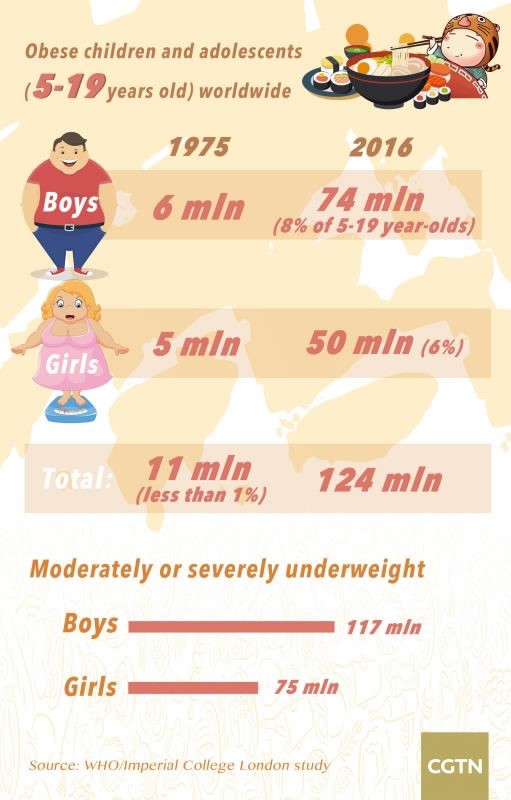
World
11:49, 11-Oct-2017
Child obesity up ten-fold since 1975: WHO study
Sim Sim Wissgott

The number of five-to-19-year-olds who are obese has grown 10-fold in the last 40 years and could soon overtake the number of those underweight, the WHO warned in a new study published on Wednesday on the occasion of World Obesity Day.
In 2016, 124 million boys and girls were found to be obese, up from 11 million in 1975, according to the study, which was conducted by the World Health Organization and Imperial College London and published in The Lancet.
Eight percent of boys – 74 million – and six percent of girls – 50 million – fell into that group.
That did not account for another 213 million children and adolescents who were seen as overweight but not obese.

CGTN
CGTN
At current rates, obese five-to-19-year-olds will outnumber those who are moderately or severely underweight by 2022, the report warned.
Currently, some 117 million boys and 75 million girls are deemed moderately or severely underweight.
“These data highlight, remind and reinforce that overweight and obesity is a global health crisis today, and threatens to worsen in coming years unless we start taking drastic action,” said Fiona Bull, a WHO specialist on non-communicable diseases.
Dramatic hike in Asia
The study was based on calculations of body mass index (BMI).

Children attend a "chubby kids' summer camp" in Beijing, China on July 20, 2013. /VCG Photo
Children attend a "chubby kids' summer camp" in Beijing, China on July 20, 2013. /VCG Photo
In all, the study’s authors analyzed height and weight measurements from close to 130 million people, making it the largest study of its kind, the WHO claimed.
The most dramatic increases could be seen in Latin America, Polynesia and Micronesia, the report found.
Elsewhere, “the trend in children’s and adolescents’ mean BMI has plateaued, albeit at high levels, in many high-income countries since around 2000, but has accelerated in east, south, and southeast Asia,” it said.
Worryingly, certain regions had quickly moved from one end of the scale to the other.
In middle-income countries in East Asia, Latin America and the Caribbean, “children and adolescents have rapidly transitioned from mostly underweight to mostly overweight,” the study found.

A seven-year-old Chinese girl eats lunch on March 22, 2017 in Changchun, China. /VCG Photo
A seven-year-old Chinese girl eats lunch on March 22, 2017 in Changchun, China. /VCG Photo
Adverse effects
Being obese or overweight carries serious health risks, including increased risks of heart disease and type-2 diabetes later on in life. But it also carries a social stigma and affects a child’s performance in school, the WHO noted.
“Gaining excess weight in childhood and adolescence is likely to lead to lifelong overweight and obesity,” it warned, issuing a call to national governments for “bolder action” – promoting healthy nutrition, encouraging physical activity and cracking down on fatty and sugary foods.
“We need ways to make healthy, nutritious food more available at home and school, especially in poor families and communities, and regulations and taxes to protect children from unhealthy foods,” the WHO urged, also pointing the finger at food marketing strategies that children and young people are especially vulnerable to.

A woman is seen drinking a large soda in New York City on October 17, 2013. Former mayor Michael Bloomberg campaigned to stop fast food restaurants from selling super-sized, sugary drinks. /VCG Photo
A woman is seen drinking a large soda in New York City on October 17, 2013. Former mayor Michael Bloomberg campaigned to stop fast food restaurants from selling super-sized, sugary drinks. /VCG Photo
What’s the situation in China?
The latest report did not give country-specific data, but the UN’s World Food Programme found last year that 23 percent of boys and 14 percent of girls under 20 in China were overweight or obese.
In May, a study by Peking University's School of Public Health predicted that 28 percent of Chinese children aged seven to 18 would be overweight or obese by 2030.
This could be attributed to a rise in white collar jobs and decline in rural work, leading to more sedentary lives, as well as increased consumption of foods high in fats and refined sugar, according to Gary Sackrison, a general practitioner at Beijing’s Vista Clinic. China’s one-child policy may have also resulted in resources – including rich foods - being concentrated on one child, he told CGTN in a recent interview.
“The tremendous wealth that has been created in China has been a blessing to its people. Unfortunately, with that wealth comes some harm,” he said.

SITEMAP
Copyright © 2018 CGTN. Beijing ICP prepared NO.16065310-3
Copyright © 2018 CGTN. Beijing ICP prepared NO.16065310-3